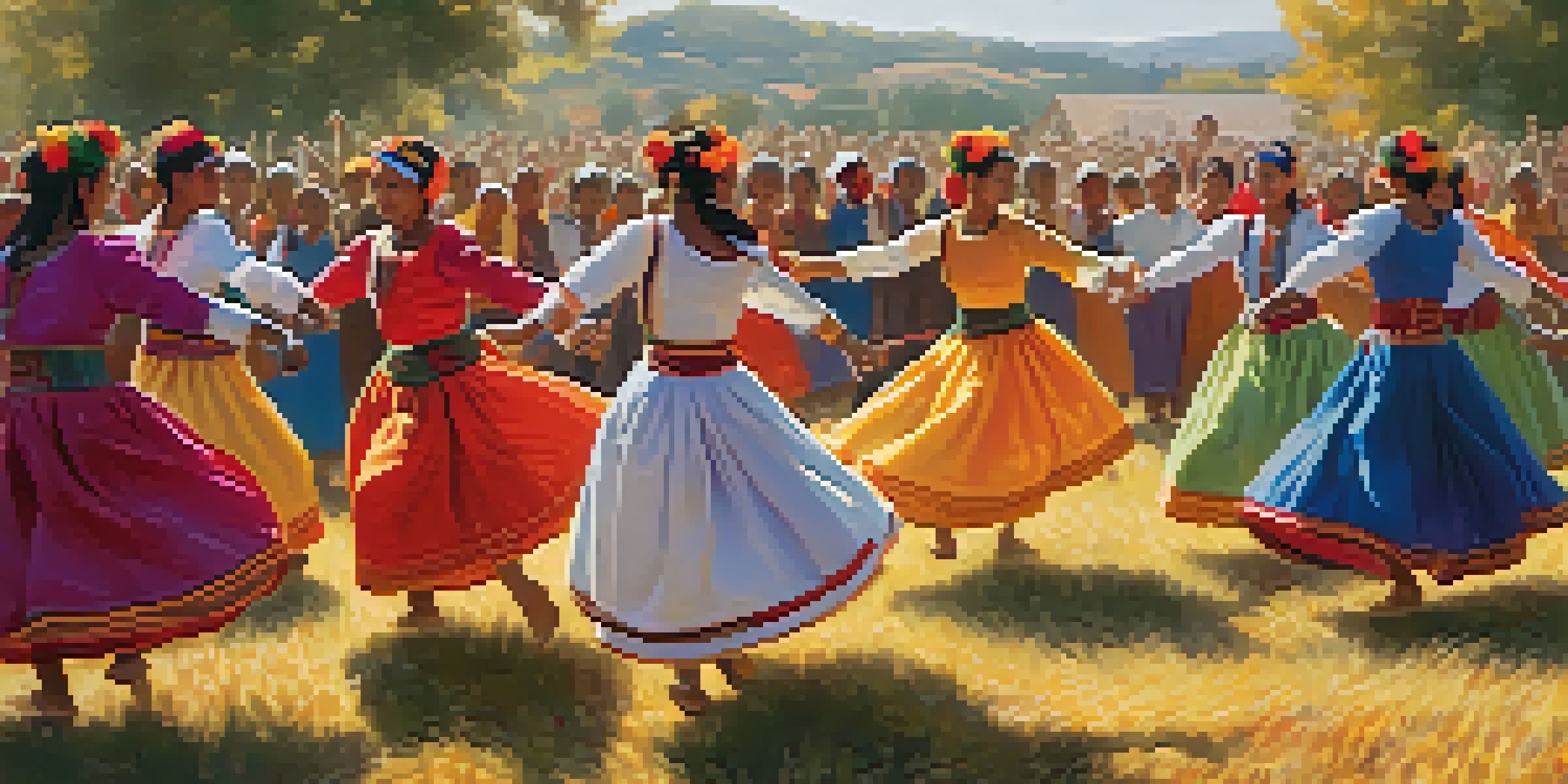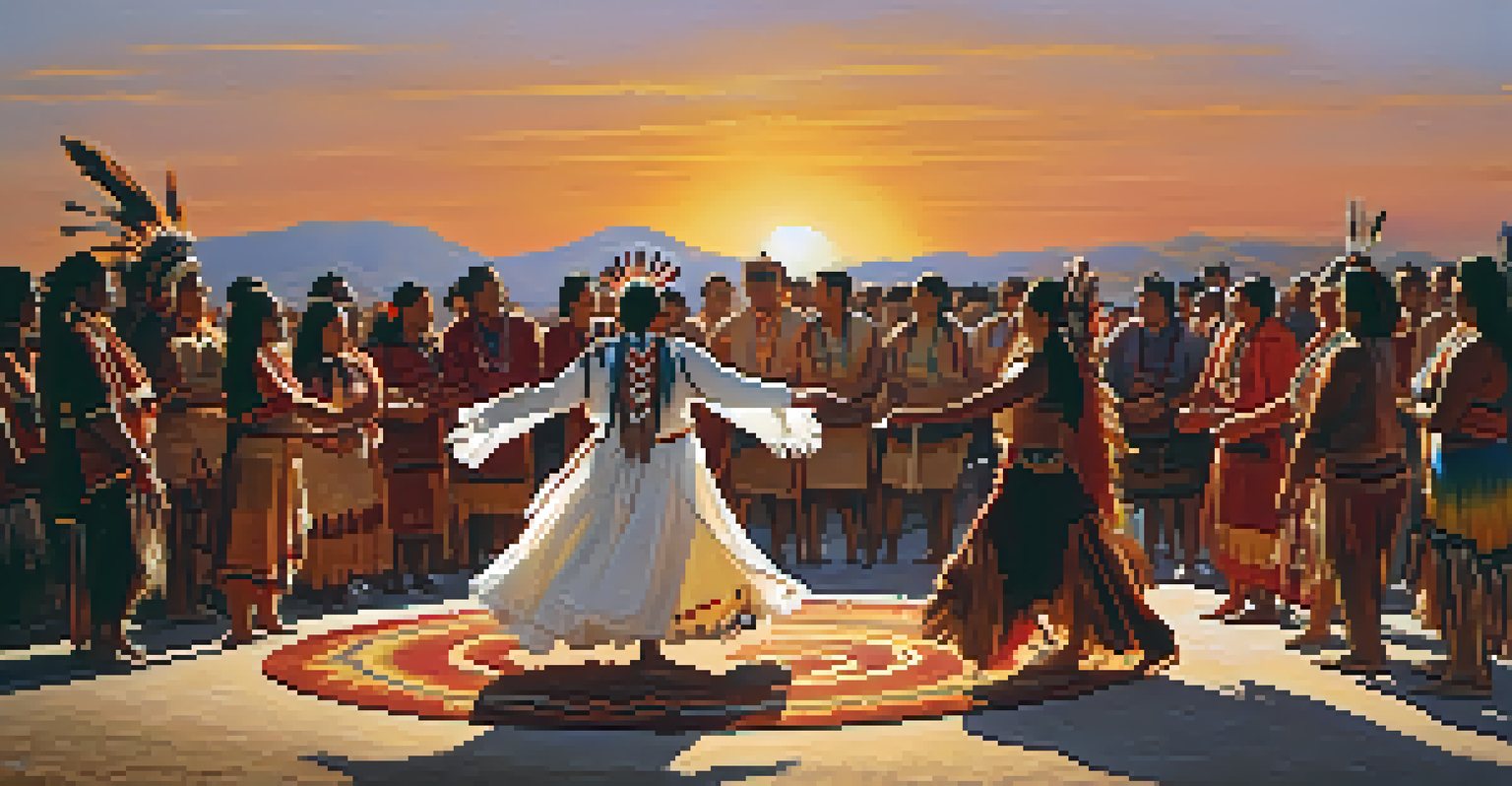The Symbolism of Dance in Folk Tales Across Cultures

Understanding Dance as a Cultural Expression
Dance has long served as a vital means of expression across cultures. In folk tales, it often embodies community values, beliefs, and traditions. For example, in many Indigenous cultures, dance is not just entertainment; it tells stories of creation, harvest, and the spirit world. This powerful form of storytelling allows communities to pass down wisdom and cultural identity through generations.
Dance is the hidden language of the soul.
Moreover, the rhythms and movements in dance can communicate emotions that words sometimes cannot. When a community gathers to dance, it fosters a sense of belonging and unity, reinforcing social bonds. This aspect of dance is particularly evident in folk tales where characters come together to celebrate significant life events, such as weddings or festivals.
Ultimately, understanding dance as a cultural expression helps us appreciate its deeper meanings in folk narratives. The movements are often choreographed to reflect the values and history of a community, making each dance unique and significant. As we explore various folk tales, we uncover how dance serves as a bridge connecting past and present.
Dance as a Symbol of Transformation
In many folk tales, dance symbolizes transformation, both personal and communal. Characters often engage in dance as a way to transition from one stage of life to another. For instance, in some African tales, initiation dances mark the passage from childhood to adulthood, highlighting the importance of community rituals in personal growth.

These transformative dances can also signify a character's inner journey. In tales where protagonists face challenges, a dance might represent their struggle and eventual triumph. The act of dancing becomes a metaphor for overcoming obstacles and embracing change, making it a powerful tool for storytelling.
Dance as Cultural Storytelling
Dance serves as a vital means of cultural expression, conveying community values and historical narratives through movement.
As we observe these transformations in folk tales, we realize that dance is not just about movement; it encapsulates the essence of growth and change. Each dance sequence carries the weight of the character’s experiences, illustrating how culture shapes individual narratives. Through this lens, we see dance as a catalyst for personal and communal evolution.
The Role of Dance in Celebrating Life Events
Folk tales often highlight dance as a vital aspect of celebrating significant life events. From weddings to harvest festivals, dance brings joy and vibrancy to these occasions. In many cultures, specific dances are performed to honor milestones, reinforcing the importance of tradition and community spirit.
The dance is a poem of which each movement is a word.
These celebrations are not just about marking an event; they are about sharing collective happiness and gratitude. For example, in European folk tales, group dances during harvest time symbolize appreciation for the earth's bounty. This communal participation fosters a sense of unity and shared purpose among the dancers.
As we explore these narratives, we recognize that dance serves as a universal language of celebration. It transcends cultural boundaries, allowing individuals to express joy and gratitude, connecting them to their heritage. Ultimately, dance becomes a celebration of life itself, encapsulating the essence of the stories being told.
Dance as a Reflection of Social Hierarchies
In many folk tales, dance serves as a mirror reflecting social hierarchies and roles within a community. Specific dances are often reserved for certain groups, showcasing the dynamics of power and status. For instance, royal courts may have their own elaborate dances that symbolize authority and privilege, while common folk engage in simpler forms of dance.
This distinction highlights how dance can both reinforce and challenge societal norms. In stories where characters defy traditional roles, dance may become a means of rebellion or self-expression. An example can be found in tales where a peasant's dance disrupts a royal event, symbolizing the desire for equality and freedom.
Dance Represents Transformation
In folk tales, dance symbolizes personal and communal transformation, marking significant life transitions and challenges.
Through these narratives, we see that dance is not merely an art form; it is deeply intertwined with social structures. By examining how dance reflects and shapes these relationships, we gain insights into the values and conflicts of a culture. Ultimately, dance becomes a powerful commentary on society itself.
The Spiritual Dimension of Dance in Folk Tales
Dance often carries a spiritual dimension in folk tales, connecting the physical world with the divine. Many cultures incorporate dance into rituals aimed at invoking spiritual guidance or celebrating deities. For instance, in Native American folklore, ceremonial dances are performed to honor spirits and seek their favor during important events.
These dances often involve specific movements and chants that hold deep spiritual significance. They serve as a way for communities to express their beliefs and connect with the broader cosmos. By participating in such dances, individuals feel a sense of purpose and belonging within their spiritual community.
As we delve into these folk tales, we recognize that dance is a conduit for spiritual expression. It allows individuals to transcend everyday life, tapping into something greater than themselves. This spiritual aspect of dance enriches the narratives, revealing the profound connections between culture, belief, and the human experience.
The Interplay of Dance and Music in Folk Narratives
Dance and music often go hand in hand in folk tales, creating a harmonious interplay that enhances storytelling. Music sets the mood and pace, while dance brings the narrative to life through movement. Together, they create a sensory experience that captivates audiences and deepens their emotional engagement with the story.
In various cultures, specific musical rhythms are closely associated with particular dances, making them inseparable. For example, in Latin American folk traditions, lively music accompanies vibrant dances, inviting participation from the community. This synergy between music and dance fosters a sense of celebration and joy, enriching the overall narrative.
Dance as Social Commentary
Through satire and irony, dance critiques societal norms, allowing characters to address injustices and empower community voices.
As we explore the relationship between dance and music in folk tales, we gain a greater appreciation for how these elements work together. They not only enhance the storytelling experience but also reflect the cultural values and traditions of a community. Ultimately, the dance-music connection highlights the richness of folk narratives and their ability to resonate across cultures.
Dance as a Tool for Social Commentary
In many folk tales, dance serves as a powerful tool for social commentary. Through satire and irony, characters use dance to critique societal norms and injustices. For instance, in some Asian folk traditions, humorous dances are performed to poke fun at authority figures, highlighting the importance of questioning the status quo.
These dances often convey messages that resonate with audiences, encouraging them to reflect on their own experiences. By incorporating dance as a means of expression, storytellers can address serious issues while still engaging their audience in an entertaining way. This duality allows for deeper connections between the narrative and the audience's reality.

As we examine the role of dance in social commentary within folk tales, we see how it empowers individuals to voice their concerns. It becomes a means of resistance, allowing communities to confront challenges collectively. Ultimately, dance offers a unique lens through which to explore and understand societal dynamics.